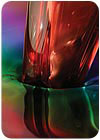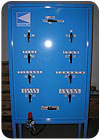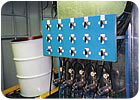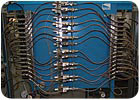Mastering the Art of Liquid Color Change
One of the key areas any liquid-coating operation should evaluate when trying to improve productivity is the liquid color change system. Using the right technology can help plants streamline even highly complex color change operations.

The speed of manufacturing demands systems that can keep plants in production. Many factors can result in production slowdowns; however, most of these challenges can be overcome with the proper planning. One of the key areas any liquid-coating operation should evaluate when trying to improve productivity is the liquid color change system.
Color changes can be accomplished by manually changing the color in a pump or pressure pot. This method is simple, but it wastes a substantial amount of time and paint - an unacceptable scenario in today’s high-production environments. Fortunately, technologies exist that can improve productivity on systems that have many color changes daily. Some options include manual color changers with remote pumping systems, semi-automatic color changers with remote pumping systems, automatic color changers with remote pumping systems, and automatic color change systems with recovery systems.

At one cabinet shop, a manual color change panel was installed at the stain application areas with a low-fluid-pressure regulator. This panel supported the overhead monorail conveyor system and two back-to-back spray booths. The color change panel was installed between the two booths, and each booth was equipped with its own fluid pressure regulator, which allowed both stain booths to operate at their own settable fluid pressure.
A second color change panel with one fluid pressure regulator was installed in the off-line booth. By having the same stain pumped from one kitchen to the two main stain areas, the on-line booths and the off-line special products booth, the stain colors have become much more repeatable, giving a good color match. This solution has allowed one main pumping system to support three separate booths from one pumping system, while also allowing each station to have independent fluid pressure control.
The stain kitchen pumps the stain from 5-gallon shipping containers. The pumps circulate the stain from the 5-gallon pails to the two manual color change panels, and then back into the pail. This closed loop allows the stain to circulate continuously though the complete stain area, which ensures a stain color match at all application areas at any given time, both short- and long-term.

The advantage of this style of color change system is that a precise amount of material is purged during the color change cycle - enough to ensure a complete color change without wasting paint. While this type of system assumes that the operator knows what the next color will be and when the color change needs to start, the system works well and is cost-effective.
One manufacturing company that uses 55-gallon drums of paint installed a semi-automatic color change panel with five independent zones in an effort to eliminate downtime associated with color changes. Each zone has nine selectable colors and a flush port. The operator selects the next color and pushes the cycle start button when required. The system controller opens a purge valve and brings the color into the selected zone. Color changes are rapid, and with the wide selection available, the production line keeps running.

At one plant, an automatic color change system reads the conveyor load bars as they come into the booth. Each booth automatically changes color as the control system reads the appropriate incoming load bars. This technology allows the system to make as many as 50 color changes per shift automatically. The color change purge material is collected for easy disposal.

With an average of 50 color changes occurring per shift at each station, the plant requires about 150 total color changes per shift. Achieving such a large number of color changes with a standard color change system would generate a great deal of color change waste. For example, an average color change with a rotary flat line system consumes about 2 gallons of stain, which would add up to 300 gallons of stain purge material per shift for this plant. Instead, the automated system has reduced that amount substantially.
The stain color change system was integrated into a PLC-controlled recovery system. This system gives each station the ability to recover almost all of the previous stain color during the color change process. As a result, only about 30 gallons of stain purge material are consumed in each shift, and most of this amount is applied to the various cabinet parts being finished.
The recovery system provides continuous stain circulation in the circulation supply loop, along with accurate pressure control at the spray guns. During each color change, the system recovers about 90% of the stain in the application spray gun loop. The recovered stain is automatically returned into the circulation loop, which allows for a cost-effective system. After the stain has been recovered, the application lines to the spray guns are cleaned with a solvent/air chop flush system. Almost all flush materials are captured for distillation recovery, which minimizes the use of flushing solvents.
For more information, visit www.exel-na.com.

The speed of manufacturing demands systems that can keep plants in production. Many factors can result in production slowdowns; however, most of these challenges can be overcome with the proper planning. One of the key areas any liquid-coating operation should evaluate when trying to improve productivity is the liquid color change system.
Color changes can be accomplished by manually changing the color in a pump or pressure pot. This method is simple, but it wastes a substantial amount of time and paint - an unacceptable scenario in today’s high-production environments. Fortunately, technologies exist that can improve productivity on systems that have many color changes daily. Some options include manual color changers with remote pumping systems, semi-automatic color changers with remote pumping systems, automatic color changers with remote pumping systems, and automatic color change systems with recovery systems.

A manual color change panel installed at the stain application areas is helping one cabinet shop ensure a stain color match at all application areas at any given time.
Manual Color Change with Remote Pumping Systems
Most cabinet shops support many different stain colors that are applied at various times during the cabinet build cycle. A typical cabinet shop might carry as many as 25 different colors. The process of getting the colors to the finishing area and then to the finishing guns in the stain systems can waste a substantial amount of time. A solution to this problem is to create a small stain pumping kitchen from which the stain is piped to the stain application areas in the plant.At one cabinet shop, a manual color change panel was installed at the stain application areas with a low-fluid-pressure regulator. This panel supported the overhead monorail conveyor system and two back-to-back spray booths. The color change panel was installed between the two booths, and each booth was equipped with its own fluid pressure regulator, which allowed both stain booths to operate at their own settable fluid pressure.
A second color change panel with one fluid pressure regulator was installed in the off-line booth. By having the same stain pumped from one kitchen to the two main stain areas, the on-line booths and the off-line special products booth, the stain colors have become much more repeatable, giving a good color match. This solution has allowed one main pumping system to support three separate booths from one pumping system, while also allowing each station to have independent fluid pressure control.
The stain kitchen pumps the stain from 5-gallon shipping containers. The pumps circulate the stain from the 5-gallon pails to the two manual color change panels, and then back into the pail. This closed loop allows the stain to circulate continuously though the complete stain area, which ensures a stain color match at all application areas at any given time, both short- and long-term.

In a semi-automatic system, the operator selects the next color required and pushes the cycle start button on a system controller at the appropriate time.
Semi-Automatic Color Change with Remote Pumping Systems
Semi-automatic color change systems feature a remote paint kitchen and a local, selectable color change panel. The operator selects the next color required and pushes the cycle start button on a system controller at the appropriate time.The advantage of this style of color change system is that a precise amount of material is purged during the color change cycle - enough to ensure a complete color change without wasting paint. While this type of system assumes that the operator knows what the next color will be and when the color change needs to start, the system works well and is cost-effective.
One manufacturing company that uses 55-gallon drums of paint installed a semi-automatic color change panel with five independent zones in an effort to eliminate downtime associated with color changes. Each zone has nine selectable colors and a flush port. The operator selects the next color and pushes the cycle start button when required. The system controller opens a purge valve and brings the color into the selected zone. Color changes are rapid, and with the wide selection available, the production line keeps running.

In completely automated systems, the color change command can come from a barcode reader, a flag system or dedicated load bars within the conveyor system.
Automatic Color Change with Remote Pumping Systems
Automatic color change systems are similar to semi-automatic systems, except that the operator doesn’t have to select the next color required in the system. The color change command can come from a barcode reader, a flag system or dedicated load bars within the conveyor system. All of the colors are pumped to the color change system from a remote paint kitchen, which often supports a number of different-sized spray booths within the system. This flexibility allows one person to prepare the colors for multiple booths.At one plant, an automatic color change system reads the conveyor load bars as they come into the booth. Each booth automatically changes color as the control system reads the appropriate incoming load bars. This technology allows the system to make as many as 50 color changes per shift automatically. The color change purge material is collected for easy disposal.

Automatic color change systems with recovery functions are the most efficient of all color change systems.
Automatic Color Change with Recovery Systems
Automatic color change systems with recovery functions are the most efficient of all color change systems. An example of this type of system is the new stain color change recovery system installed at Huntwood Cabinetry in Liberty Lake, WA. The company uses 12 standard stain colors that are pumped from a remote paint kitchen. The paint kitchen supports three separate, automatic, flat line stain systems (one each for the front and back sides of standard cabinet parts, and an auxiliary parts booth). All three booths use the same 12-color stain pumping system and can be in use at the same time or at different times. This flexibility ensures repeatable colors from all three stations.With an average of 50 color changes occurring per shift at each station, the plant requires about 150 total color changes per shift. Achieving such a large number of color changes with a standard color change system would generate a great deal of color change waste. For example, an average color change with a rotary flat line system consumes about 2 gallons of stain, which would add up to 300 gallons of stain purge material per shift for this plant. Instead, the automated system has reduced that amount substantially.
The stain color change system was integrated into a PLC-controlled recovery system. This system gives each station the ability to recover almost all of the previous stain color during the color change process. As a result, only about 30 gallons of stain purge material are consumed in each shift, and most of this amount is applied to the various cabinet parts being finished.
The recovery system provides continuous stain circulation in the circulation supply loop, along with accurate pressure control at the spray guns. During each color change, the system recovers about 90% of the stain in the application spray gun loop. The recovered stain is automatically returned into the circulation loop, which allows for a cost-effective system. After the stain has been recovered, the application lines to the spray guns are cleaned with a solvent/air chop flush system. Almost all flush materials are captured for distillation recovery, which minimizes the use of flushing solvents.
Improving Color Change Productivity
Color changes are often a time-consuming, wasteful process in a finishing operation - but they don’t have to be. By implementing modern technologies, plants can automate and streamline their color changes and can recover a majority of their purge and cleaning materials to create a highly efficient, and more profitable, operation.For more information, visit www.exel-na.com.
Looking for a reprint of this article?
From high-res PDFs to custom plaques, order your copy today!



